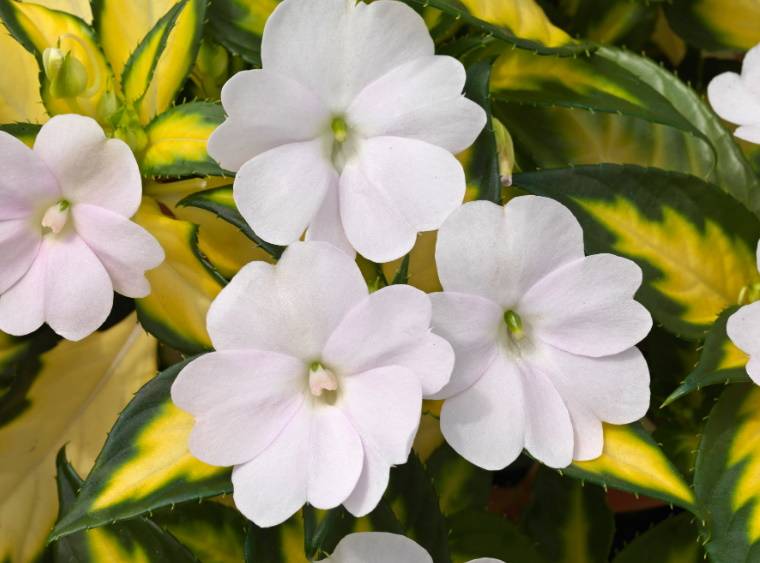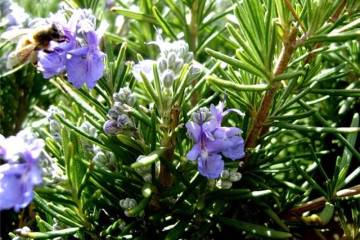Balsam New Guinea - growing at home and in the garden
Content:
Low bushes of New Guinea balsam, with intensely colored stems and leaves, decorated with large flowers of noble shades, have recently entered the collection of hybrid balsams. They have become favorites among lovers of indoor lights and touchy, as balsams have long been called in Russia.
Description and history of New Guinea balsam
Balsams have many names, both in European countries and in Russia, their names are associated with the characteristic features of plants. The Germans, speaking of the long-flowering flower Zealous Lisa, mean a plant that belongs to the Balsaminaceae family, to the Impatiens genus. Russians call this flower Wet Vanka for its ability to release drops of sweet liquid before rain.
But all these plants also have scientific names. Florists divided balsams into varieties, each of which got its own name. Breeders have improved the appearance, vegetative and generative characteristics of balsamic plants. Among the new plant species at the beginning of the 21st century, the most famous were representatives of the Balsaminaceae family, which were artificially created on the basis of the genetic material of Hawker's balsam and other balsamic species. They were combined into a group of plants under the general name New Guinea Balsam (Impatiens neuguinea).
These flowers belong to perennial shrubs, differ from the usual species of Impatient in that they have more powerful stems up to 60 cm high, can be variegated or with stems and leaves painted with anthocyanin. Inflorescences of plants are painted in white, orange, burgundy, lilac, pink, lilac shades; can be monochrome and two-color, of various shapes. Flowers emit a strong aroma, have petals and buds of various shapes.
Plants obtained from seedlings are different from mother balsams. Hybrids with heterotic qualities - increased vitality were created especially for cold climates. This group of plants can be grown outdoors in the garden, on terraces, in hanging flowerpots. Home growers use hybrid indoor plants and propagate them using cuttings. At home, New Guineans can bloom for at least 10 months a year.
Varieties of Impatiens neuguinea
New Guinea hybrids appeared on the market at the end of the last century, but are still considered unique plants. Only a few hybrids are widely known. These include:
- Divaro balsamic bushes with a dense crown and compact scarlet flowers.
- A hybrid of orange shades of Macarena, with orange-colored inflorescences and bronze leaves.
- Dark green Rainforest Exotic plants with a variety of colors.
- A series of large-flowered plants under the general name Devine mix. It includes hybrids with brightly colored flowers and leaves of a bronze and dark green tint.
- Balsam Guinean Jangle Rain has flowers of delicate shades that look advantageous against the background of bright, green color, leaves.
- New Zealand balsam Harmony is distinguished by the color of the leaves, painted in shades from golden to red.
- The Mini Gini hybrid is known for the fact that many buds are formed on the bushes, from which small flowers bloom.
- Spreading White is a mix of snow-white inflorescences and variegated yellow-green leaves.
Outdoor and home care for Guinean balsam
These flowers require the same care as for ordinary Lights and Impatiens.
Illumination and temperature conditions
Impatiens neuguinea hybrids are thermophilic light-tolerant plants. Outdoors, they are grown in a slight partial shade. In hot midday hours, garden flowers need protection from the scorching sun. In the room, flower growers with Impatiens neuguinea display on the southern and eastern windowsills, while providing temporary diffused lighting using gauze or mesh materials.
The duration of flowering and vegetative processes of plants depends on the intensity of illumination. In order for the buds to form on the bushes and flowers to bloom, it is necessary that the duration of daylight hours is at least 14 hours. For flowering, an optimal air temperature is required in the range of 18-25 ° C. Plant development will stop if the air temperature drops below 10 ° C.
Watering rules and humidity
At home, when caring for New Guinea balsam, it is necessary to create conditions similar to natural ones. The homeland of all types of balsam is the southern regions with a humid tropical climate, therefore, the air in the room where Impatiens neuguinea is grown or propagated must be saturated with water.
The humidity level is maintained within 70-75%. Outdoors, plants are watered and regularly sprayed with standing water at outdoor temperatures. They use a fine spray so as not to damage the stems and leaves of flowers, which are characterized by increased fragility and fragility.
Top dressing and soil quality
Plants are fed no more often than once a month and a half with complex fertilizers, which include nitrogen, phosphorus, potassium and trace elements. For planting Impatiens neuguine, a permeable soil with neutral acidity is used.
Flower container size
All Impatiens species are grown in shallow flower beds, in which the roots of the plants will be slightly cramped. Only in this case, many peduncles will appear on the bushes.
Pruning and replanting
Balsams need pinching and pruning to build side shoots. The plants are transplanted after the roots of the flowers begin to peep out of the drainage holes of the flower pots.
What to do with a flower in winter
For 2-3 cold months for Impatiens neuguinea create resting conditions: reduce the ambient temperature to 12 ° C, reduce the intensity of lighting and watering. In winter, flowers are not placed near heating appliances and in drafts.
The dormant period is a very good time to trim flowers. This will make it possible to propagate hybrids by rooting the cut stems. In addition, plants are cut in spring and summer, but in this case, pruning can cause the balsams to shed flower ovaries.
Diseases and pests
Flowers need to be treated with modern biosecurity preparations against larvae and adults of whiteflies, spider mites and aphids. The same means are used to prevent fungal diseases.
Many household plots, squares and parks are decorated with balsams.They grow on balconies and can be seen through window panes. It is very beautiful, especially if these are plants from the Impatiens neuguinea group.




















